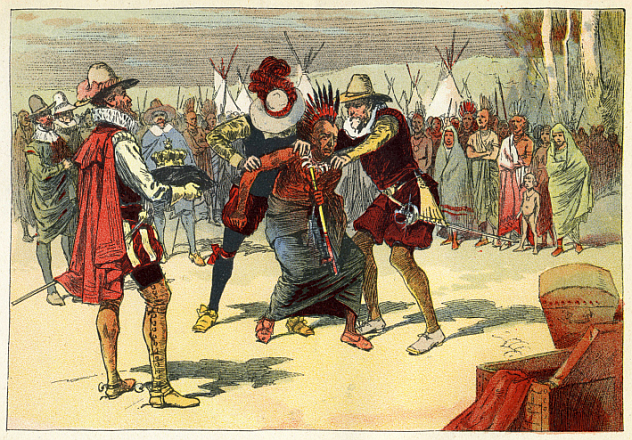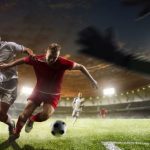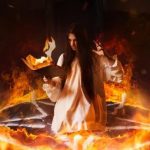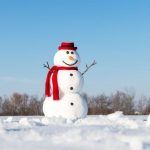 Weird Stuff
Weird Stuff  Weird Stuff
Weird Stuff  Our World
Our World 10 Ways Your Christmas Tree Is More Lit Than You Think
 Movies and TV
Movies and TV The 10 Coolest Stars to Set Sail on The Love Boat
 History
History 10 Things You Didn’t Know About the American National Anthem
 Technology
Technology Top 10 Everyday Tech Buzzwords That Hide a Darker Past
 Humans
Humans 10 Everyday Human Behaviors That Are Actually Survival Instincts
 Animals
Animals 10 Animals That Humiliated and Harmed Historical Leaders
 History
History 10 Most Influential Protests in Modern History
 Creepy
Creepy 10 More Representations of Death from Myth, Legend, and Folktale
 Technology
Technology 10 Scientific Breakthroughs of 2025 That’ll Change Everything
 Weird Stuff
Weird Stuff Ten Bizarre Facts About The Doge Meme
 Our World
Our World 10 Ways Your Christmas Tree Is More Lit Than You Think
 Movies and TV
Movies and TV The 10 Coolest Stars to Set Sail on The Love Boat
Who's Behind Listverse?

Jamie Frater
Head Editor
Jamie founded Listverse due to an insatiable desire to share fascinating, obscure, and bizarre facts. He has been a guest speaker on numerous national radio and television stations and is a five time published author.
More About Us History
History 10 Things You Didn’t Know About the American National Anthem
 Technology
Technology Top 10 Everyday Tech Buzzwords That Hide a Darker Past
 Humans
Humans 10 Everyday Human Behaviors That Are Actually Survival Instincts
 Animals
Animals 10 Animals That Humiliated and Harmed Historical Leaders
 History
History 10 Most Influential Protests in Modern History
 Creepy
Creepy 10 More Representations of Death from Myth, Legend, and Folktale
 Technology
Technology 10 Scientific Breakthroughs of 2025 That’ll Change Everything
10 of the Worst Things That Happened Around Christmas
The Christmas season is one of the most venerated times of year around the world, celebrated by Christians and non-Christians alike. Purported to be one of the happiest times of year, there have also been a number of terrible events which occurred. Here are 10 of the worst events to happen around Christmas.
10 The Tangiwai Disaster
1953

In the late hours of Christmas Eve, as a passenger train carrying nearly 300 people came barreling down the tracks near the Whangaehu River in New Zealand, tragedy struck: The bridge had been severely weakened due to flooding from nearby Crater Lake. Nearly 350,000 cubic meters (12.4 million ft3) of water came pouring down the valley, picking up dirt and debris until it was a deadly mudslide. It reached the bridge before the train, damaging most of the support structure.
The driver of the train was warned by a nearby motorist about the bridge’s condition, but he was unable to stop in time. He drove onto the bridge, which collapsed under the weight of the train, and the train plunged into the river below. Onlookers were able to rescue some of those trapped inside, but 151 people perished inside the carriages. In a morbid twist, Tangiwai means “weeping waters” in Maori, the tongue of the native New Zealanders.
9 The Acteal Massacre
1997

In an impoverished area in the Mexican state of Chiapas, a small town known as Acteal was rocked when a paramilitary group known as the Masque Roja (Red Mask) attacked a Roman Catholic prayer group made up of indigenous people. By the time they fled the scene, 45 people had died, including 21 women and 15 children. Most people attribute the crime to a dispute between the ruling party at the time and nearby rebels, who were supported by the members of the prayer group.
What makes the whole situation worse is that local police, as well as the governor, were either completely negligent or deliberately helping the murderers, who some claimed were wearing state-police uniforms. Others say that the police tampered with the crime scene after the Masque Roja had left. While dozens of people have since been convicted of the crime, the situation is still extremely cloudy thanks to the lack of transparency on the part of the Mexican government.
8 Kim Il-Sung Becomes President Of North Korea
1972

Though he was the premier of the country since 1948, leading the country through the Korean War and the decades that followed,Kim Il-sung didn’t become the president until 1972. Upon receiving the title of president, Il-sung turned from the economic programs (Juche, or “self-reliance”) which had dominated North Korean life and began spending an unprecedented amount on the country’s military. A few years prior, he had begun laying the groundwork for the “Great Leader” cult personality which came to embody him, as well as his successors. Thanks to a highly coordinated and precise system of propaganda, Il-sung remained essentially unchallenged for his entire 46-year rule, a reign punctuated by various periods of antagonism toward South Korea.
Buoyed for years by its Communist ties to China and the Soviet Union, North Korea underwent a period of economic disaster and famine after the collapse of the USSR and the cessation of the money that came with it. He may not be seen as the terror that his son Kim Jong-il was to the people of North Korea, but the steps Il-sung took in setting up his own presidency, as well as the effective designation of Jong-il as his successor, led to the travesty that is present-day North Korea.
7 The Italian Hall Disaster
1913

A few months after a strike at Michigan’s largest copper mining company was started, as a result of management’s refusal to meet with the union, the workers decided to hold a Christmas party on December 24. To boost morale, the party was held in a large building, the Italian Hall, and nearly 600 people, including children, flocked there to enjoy themselves.
During the festivities, an unknown person shouted the word “fire,” in an effort to scare the attendees. It was successful, as a massive, panicked stampede to the nearest stairwell immediately commenced. Unfortunately, 73 people, of which 62 were children, were killed. To this day, the identity of the yeller is a mystery, and it remains the largest unsolved manslaughter in US history. (Rumors persist that it was someone associated with the mining company that shouted “fire,” but it’s never been proven.)
6 The Laws Of Burgos Are Established
1512

Given the horrible mistreatment Native Americans had suffered at the hands of nearly every European with which they had come into contact up to this point, any semblance of reform seemed like a good idea. In actuality, the Laws of Burgos did basically nothing to help the natives thanks to the lack of enforcement, and even seemed to demean the natives even more, with comments about their alleged laziness and proclivity to vice in the preamble of the Laws. At that time, it was extremely difficult to enforce the rules, given that it took months just to cross the Atlantic. The Laws, which had genuinely offered an improvement to how Native Americans were treated, instead became a justification for the existing, horrifying practices already in place.
However, thanks to the efforts of some Dominican missionaries, the plight of the natives was brought up to the King of Spain, who feigned ignorance but, nevertheless, set up a council to draft rules for the treatment of the natives. Chief among them was the forced conversion to Christianity, which the Spanish saw as a non-negotiable necessity. Other travesties included the forced removal of them from their land, which was subsequently burned so they could not return to it. They were also forced to work for the Spanish for two years regardless of whether or not they wanted to. (Afterward, with two years’ worth of lessons in Christianity included, they were said to be free men.)
5 Fire At The Library Of Congress
1851

While not as devastating to humanity as the destruction of the Library at Alexandria, the fire which obliterated the Library of Congress on Christmas Eve in 1851 was still a major loss, especially to historians of Thomas Jefferson. The former president had sold his collection, the largest in the country at the time, to the government after the British had burned the entire Library to the ground. When the latest fire struck the building, nearly all of Jefferson’s book collection fell victim to the flames.
In total, nearly two-thirds of all the books in the Library were burned to a crisp, leaving Congress to spend a fortune replacing whatever they could. Unfortunately, it was miniscule to the cost of fireproofing the library, an idea which had been suggested in 1826, after a candle left burning almost set the place ablaze. (The suggestion was denied as it was deemed too expensive.)
4 Erzincan Earthquake
1939

Still the worst natural disaster in the history of the country, the earthquake which struck Turkey in 1939 claimed over 30,000 lives, mostly as a result of terribly designed buildings and engineering problems throughout the area. Shortly after Christmas, during another of the tough Turkish winters, seven separate quakes hit northern and eastern Turkey, completely wiping out smaller towns, with the disaster exacerbated thanks to a blizzard which followed.
The earthquake was given its name because of the complete destruction it caused to the city of Erzincan, with nearly every citizen in the nearby area falling victim to either the quake or the intense cold from the blizzard. In an example of a dark cloud with a silver lining, the Turkish government quickly (for a bureaucracy) adopted much more strict and uniform building codes, finally taking into account the idea of lateral movement in their buildings. This was important as the country is home to the North Anatolian Fault, a fault line similar to the San Andreas Fault found along the western coast of the United States.
3 The Ku Klux Klan Is Formed
1865

Just after the end of the Civil War, when it became obvious that the South was going to be forced to undergo a drastic change as a result of the emancipation of all their former slaves, as well as the federal government’s Reconstruction efforts, a group of Confederate veterans met and decided to form a secret society dedicated to stopping or reversing those changes. Derived from the Greek word for “circle” and the Gaelic version of “clan,” the KKK utilized an extremely thorough and dedicated system of violent oppression to fight the Reconstruction.
However, their efforts might have had the opposite effect: Many Northerners saw what the KKK was doing and assumed the South “hadn’t learned their lesson.” This resulted in widespread victories for the Republicans, who passed increasingly harsher laws to combat the racism in the South. One such rule, later declared unconstitutional, was the Ku Klux Klan Law, which gave the government far-reaching powers when fighting against a terrorist organization, up to and including military force. (Nine separate counties in South Carolina were actually put under martial law as a result, with thousands being arrested.)
2 Soviet Invasion Of Afghanistan
1979

In 1978, the government of Afghanistan was overthrown in a military coup and turned over to two different Communist groups. Thanks to unpopular reforms, as well as the forging of close ties with the Soviet Union, unrest began to stir among the populace, with an Islamic insurgency known as the mujahideen forming a short while later. As a result of their increased activity, the Soviet Union decided to invade the country, sneaking in under cover of darkness on Christmas Eve 1979.
This was the first and only time the Soviet Union invaded a country outside the Eastern Bloc, and the decision was met with worldwide denunciation. As part of their effort to stem the growing influence of their enemy in the Cold War, the US began training the mujahideen, as well as giving them weapons. As we all know, shortly after the decade-long Soviet occupation ended, the Taliban took over the country, allowing Osama bin Laden and Al-Qaeda a chance to train and launch terrorist attacks across the globe, the worst of which hit the very country which helped them in the first place.
1 Black Christmas
1941

Shortly after their successful attack on Pearl Harbor, Japan’s military turned its sights to Hong Kong, which was defended by only a token amount of Allied soldiers who served as little more than a symbol of Britain’s wish to keep Japan out of the country. (The forces consisted of British, Canadian, and Indian soldiers.) The fighting lasted for a few weeks, as the Japanese had an overwhelming advantage in manpower and firepower, culminating in the Allies’ surrender on Christmas.
However, like they did to virtually every place they occupied during World War II, Japan went completely crazy, starting a four-year campaign of systematic torture of POWs and civilians, as well as the unmitigated rape of untold women. Various instances, including the St. Stephen’s College massacre and the Mui Wo massacre, took place, with many of the guilty soldiers later convicted of war crimes.
+ Birth Of Karl Rove
1950

Although this might not be applicable, depending on your political bent, there’s no denying Karl Rove played a large role in the Republican victories throughout the US from 2000 to 2008. As the key strategist for the party, it was his ideas of ignoring the moderate vote and focusing on expanding the extremists that have helped turn the country into two incredibly partisan and divided groups. Also, since he had a hand in George W. Bush’s gubernatorial victories, who would know what would have happened to the country had Bush never left the confines of Texas?
In addition, Rove has been at the forefront of introducing more and more money into the election process, primarily with his American Crossroads super PAC, which spent hundreds of millions during the 2012 election. (He was also responsible for helping amass a total of $1 billion for the Republicans through a number of other entities.) The stunning defeat of the candidates he backed, as well as the controversies he’s been engulfed in since then, may signal the end of the man once seen as the mastermind of the Republicans.








